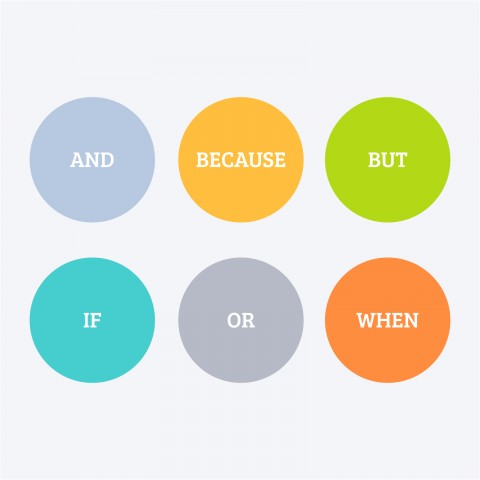Hindi conjunctions are quite significant to the whole framework of the Hindi language. Just like in English, conjunction words in Hindi do the job of cementing two correlated sentences or phrases together.
One can easily find a conjunction in Hindi PDF online. But as a beginner, if you don’t understand the concept first, the meaning of conjunctions in Hindi and conjunction grammar rules in Hindi would be difficult to comprehend. This makes it imperative to learn Hindi conjunctions from the ground up, and becoming familiar with the most common Hindi conjunction words.
Table of Contents
- Importance of the Conjunction in Hindi
- Hindi Conjunctions: Definition and Concept
- Hindi Conjunctions: Types & Exercises
- About the Hindi Conjunction List
- Conjunctions to Correlate Similar Thoughts
- Conjunctions to Express Condition
- Conjunctions to Express Cause
- Conjunctions to Express Opposition
- Conjunctions to Express Purpose
- Conjunctions to Express Alternatives
- Grow Your Hindi Knowledge with HindiPod101.com
1. Importance of the Conjunction in Hindi
In Hindi grammar, conjunctions are vital. Without the use of conjunctions in Hindi, even a proper sentence structure would lose its meaning and create enormous confusion!
It’s the conjunction in Hindi that specifies whether two joined sentences contain similar thoughts, reflect two completely unrelated thoughts, or express a condition or underlying cause.
The bottom line is that the conjunction in Hindi grammar is something you just can’t afford to miss! Hindi sentences with conjunctions are just so much more sensical and fluid.
So, why don’t we start with the conjunction definition in Hindi before covering our complete conjunction list with Hindi words!
2. Hindi Conjunctions: Definition and Concept
What is a conjunction? A conjunction is a word or phrase that connects two or more words or phrases in a sentence. There! You’ve got the simplest definition for it.
In literal terms, the conjunction meaning in Hindi is संयोजन (SanyojaN), whereas for the word “conjunctive,” the meaning in Hindi would be संयोजक (Sanyojak) or जोड़ने वाला (jodaNe vaaLaa).
Adding to that, the natural translation and meaning of “all conjunctions” in Hindi would be सभी संयोजक (Sabhii Sanyojak).
And while we’re at it, let’s quickly check out how to say “connectors” in English with the Hindi word. The connectors are called योजक (yojak) in Hindi.
3. Hindi Conjunctions: Types & Exercises
The conjunction in Hindi is divided and then subdivided into many categories. The two main classes are Coordinating Conjunctions and Subordinating Conjunctions.
1- Coordinating Conjunctions in Hindi
The coordinating conjunctions in Hindi are also known as the cumulative conjunction in Hindi. These are the words or phrases which are used to join two similar clauses or phrases of equal importance. For example: “and,” “but,” “so,” “for,” etc.
2- Subordinating Conjunctions in Hindi
The function of the subordinate conjunction in Hindi is to connect a dependent clause with an independent clause in a sentence. For example: “because,” “although,” “until,” etc.
Now that we have a basic idea about the two main types of conjunctions, it will be easier to understand the English conjunction in Hindi in more detail.
In the section below, we’ll study a comprehensive Hindi conjunction examples list with Hindi conjunctions in English as well as Hindi, to not only help you learn Hindi connecting words, but also craft Hindi conjunction sentences.
4. About the Hindi Conjunction List
Finally, it’s time to go through the list of connectors. This conjunction list (English to Hindi) is a great way to practice and improve spoken and written Hindi in daily life.
We would also like to draw your attention to the fact that there can be multiple conjunctions with a similar meaning. So, while translating a conjunction, don’t be surprised if you come across conjunction with more than one word for it.
Without further ado, our comprehensive Hindi conjunctions list and several Hindi conjunctions examples!
5. Conjunctions to Correlate Similar Thoughts
The most common English conjunction words to express two similar thoughts together are “and” and “also.” But how do you say them in Hindi? Find out in this full list of conjunctions in Hindi for correlating similar thoughts.
1- And
Normally, in everyday conversations, Indians opt for और (aur) in place of “and.” In most cases, it comes between two clauses or words. But sometimes, और (aur) can be placed at the beginning of the sentence. This happens when the person has finished talking but needs to add something important (probably because he or she forgot to do so in the first place).
Example:
- मुझे आम पसंद है। मुझे सेब पसंद है।
(mujhe aam paSaND hai. mujhe Seb paSaND hai.)
“I like mangoes. I like apples.” - मुझे आम और सेब पसंद हैं।
(mujhe aam aur Seb paSaND hain.)
“I like mangoes and apples.”
The other substitutes for और (aur) are व (va), तथा (TaTHaa), and एवं (evam). Keep in mind that they’re rarely spoken in day-to-day Hindi conversations and are merely confined to official uses. However, these can be used in the same way as the above example.
For instance, here are these conjunctions in Hindi with examples:
- मुझे आम तथा सेब पसंद हैं।
(mujhe aam TaTHaa Seb paSaND hain.)
“I like mangoes and apples.” - मुझे आम व सेब पसंद हैं।
(mujhe aam va Seb paSaND hain.)
“I like mangoes and apples.”
6. Conjunctions to Express Condition
Talking about a particular (necessary) condition requires the speaker to use certain other kinds of conjunctions.
2- If/Then
In situations where people like to express a peculiar condition, the Hindi phrases अगर (agar) / तो (To) are used. The examples below will help you understand how to use it in a sentence.
Example:
- अगर तुम थक गयी हो, तो सो जाओ।
(agar Tum THak gayii ho, To So jaao.)
“If you’re tired, then get some rest.”
अगर (agar) / तो (To) can easily be replaced with यदि (yaDi). Although यदि (yaDi) is more formal and less frequently used in daily Hindi talks and chats, Indians still prefer to use it in official documents.
Example:
- यदि आज बारिश हुई, तो दफ़्तर बंद रहेगा।
(yaDi aaj baaris huyii, To DafTar baND rahegaa.)
“If it rains today, the office will remain closed.”
As you can see, having a voluminous vocab in Hindi is great, but it’s not a substitute for learning parts of speech, such as prepositions and conjunctions in Hindi.
3- Since
Another terrific conjunction in Hindi is “since.” In Hindi, it’s translated as चूंकि (cuunki). The unique thing about this word is that more often than not, it’s placed at the beginning of a sentence. In Hindi conjunction sentences, it may look something like the example below.
Example:
- चूँकि तुम मेरे दोस्त हो, मैं तुम्हारी मदद करूंगी।
(cuunki Tum mere DoST ho, main Tumhaarii maDaD karuungii.)
“Since you are my friend, I’d like to help you out.”
7. Conjunctions to Express Cause
There are times when things go wrong, or at least they don’t really happen the way we expected. In such cases, we need to express causes and reasons using conjunctions in Hindi grammar. In this section of the Hindi conjunctions list, we’ll shed some light on these similar conjunctions.
4- So
You’ll hear Indians using this word quite frequently. In Hindi sentences, “so” means इसलिए (iSLiye). Let’s see how it connects two similar clauses below.
Example:
- सीमा की बस छूट गयी थी, इसलिए उसे देर हो गयी।
(Siimaa kii baS chuut gayi THii, iSaLiye uSe Der ho gayii.)
“Seema missed her bus, so she was late.”
5- Before
The conjunction “before” translates as पहले (pehLe). पहले (pehLe) is placed in between two clauses, but at times it may also be placed at the beginning of the sentence.
Example:
- फ़ल और सब्ज़ियों को खाने से पहले हमेशा धो लेना चाहिए.
(faL aur Sabziyon ko khaaNe Se pehLe hamesaa DHo LeNaa caahiye.)
“You should always wash vegetables and fruits before eating them.”
6- Because
Sometimes, it becomes necessary to give valid reasons for why things didn’t go as you planned! In such cases, the conjunction “because” comes to your rescue. In Hindi, it’s known as क्योंकि (kyonki) and is an inseparable part of daily Hindi chitchats.
Example:
- बाज़ार बंद है क्योंकि आज रविवार है।
(baazaar baND hai kyonki aaj ravivaar hai.)
“The market is closed because it’s Sunday today!”
8. Conjunctions to Express Opposition
But what about when we have to express contradiction? Whoa! Did you notice the conjunction we used so seamlessly? Yes, you’ve guessed it right. Our next word is “but.”
7- But
The conjunction “but” can be translated into multiple words in Hindi. And we’ll share at least four of them with you.
We’ll start with the most popular one, which is लेकिन (LekiN). लेकिन (LekiN) is rightfully visible everywhere, in daily talks, in books, on the news, etc. So, let’s see how to put it in a sentence.
Example:
- मेरी तबियत ख़राब है लेकिन मुझे विद्यालय जाना होगा।
(merii TabiyaT kharaab hai LekiN mujhe viDyaaLay jaaNaa hogaa.)
“I am not well but I must go to school.”
The other regularly used translations for “but” are परन्तु (paraNTu), मगर (magar), and पर (par). They work in the same way as लेकिन (LekiN).
Example:
- दिल्ली अच्छा शहर है पर वहाँ प्रदूषण बहुत है।
(DiLLii acchaa sahar hai par vahaan praDuusan bahuT hai.)
“Delhi is a great city, but it’s highly polluted.”
8- And yet
The Hindi phrase for “and yet” is फिर भी (phir bhii). It serves the same purpose, indicating contradiction or opposition. You can understand this better with the example below.
Example:
- राज ने इतनी मेहनत की, फिर भी वह परीक्षा में पास नहीं हो पाया।
(raaj Ne iTaNii mehaNaT kii, phir bhii vah pariiksaa men paaS nahiin ho paayaa.)
“Raj worked so hard, and yet he couldn’t clear the exams.”
9. Conjunctions to Express Purpose
How do you convince people? Well, whatever skills you use for that, it can’t be done without conjunctions for expressing purpose. And our first one in the conjunction words list is “so that.”
9- So that
In Hindi, saying ताकि (Taaki) is a great way to persuade people and bring more conviction to your speech.
Example:
- रोज़ कसरत करो, ताकि स्वस्थ रह सको।.
(roz kaSaraT karo, Taaki SvaSTH rah Sako.)
“Exercise daily, so that you stay healthy.”
10- That’s why
When you’re in a position to give reasons and explanations, इसलिए (iSLiye) is the perfect Hindi word you’re looking for.
Example:
- आज क्रिसमस है इसलिए हम सबने नए कपड़े पहने हैं।
(aaj Christmas hai iSaLiye ham SabaNe Naye kapade pahaNe hain.)
“It’s Christmas today, and that’s why we have all put on new clothes.”
10. Conjunctions to Express Alternatives
11- Or
“Or” is heavily used in Hindi conversation, maybe while requesting food preferences, choice of beverage, clothing, or anything like that. In Hindi, it can be translated as अथवा (aTHavaa) or या (yaa).
Example:
- तुम्हें भारत ज़्यादा पसंद है या जापान?
(Tumhen bhaaraT zyaaDaa paSaND hai yaa JaapaaN?)
“Do you like India better, or Japan?”
12- Either … Or
“Either … or” is just an extended version of “or.” Its Hindi translation is या तो (yaa To) … या फिर (yaa phir). No matter how much we try to put the concept into words, it’s much better to learn it through sentence usage.
Example:
- या तो मैं फ़िल्म देखूँगा या फिर ख़रीदारी करूँगा।
(yaa To main fiLm Dekhuungaa yaa phir khariiDaarii karuungaa.)
“Either I’ll watch a movie or I’ll go shopping.”
13- Otherwise
Another common and widely used term to indicate contradictions is वरना (varNaa). It’s a popular word and worth learning if you’re going to be staying in India for a while.
Example:
- जल्दी करो वरना हमें देर हो जाएगी।
(jaLDii karo varaNaa hamen Der ho jaayegii.)
“Hurry up, otherwise we’ll be late.”
14- Instead of
The last conjunction in our all conjunction list with Hindi words is “instead of,” which simply means के बजाय (ke bajaay) in Hindi.
Example:
- सुमित को घूमने के बजाय पढ़ना ज़्यादा पसंद है।
(SumiT ho ghuumaNe ke bajaay padhaNaa zyaaDaa paSaND hai.)
“Instead of going out, Sumit prefers reading.”
11. Grow Your Hindi Knowledge with HindiPod101.com
We hope you’ve loved and enjoyed this piece of ours on Hindi linking words & exercises! For amazing learners like you, we have so much more to offer and share on HindiPod101.com.
Learning has no end, and neither does our Hindi resources section! We bet our word bank and vocab lists, enjoyable lesson materials, interesting blog articles, and enriching grammar bank will be worth your time.
Simply download our mobile application and let us help make your learning experience even better and more fun. Just sign up on our homepage and get started already!
And before you go, let us know how you feel about conjunction words in Hindi now. Do you feel more confident using them, or are there still some things you’re having a hard time grasping? Let us know in the comments; we look forward to hearing from you!



















